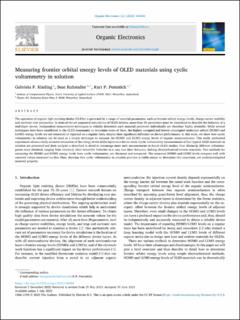Please use this identifier to cite or link to this item:
https://doi.org/10.21256/zhaw-28351Full metadata record
| DC Field | Value | Language |
|---|---|---|
| dc.contributor.author | Kissling, Gabriela P. | - |
| dc.contributor.author | Ruhstaller, Beat | - |
| dc.contributor.author | Pernstich, Kurt P. | - |
| dc.date.accessioned | 2023-07-27T09:27:32Z | - |
| dc.date.available | 2023-07-27T09:27:32Z | - |
| dc.date.issued | 2023 | - |
| dc.identifier.issn | 1566-1199 | de_CH |
| dc.identifier.uri | https://digitalcollection.zhaw.ch/handle/11475/28351 | - |
| dc.description.abstract | The operation of organic light emitting diodes (OLEDs) is governed by a range of material parameters, such as frontier orbital energy levels, charge carrier mobility and excitonic rate parameters. In state-of-the art numerical simulations of OLED devices, more than 30 parameters must be considered to describe the behavior of a multilayer device. Independent measurement techniques to reliably determine each material parameter individually are therefore highly desirable. While several techniques have been established in the OLED community to determine some of them, the highest occupied and lowest unoccupied molecular orbital (HOMO and LUMO) energy levels are not measured or reported on a regular basis, despite their significant influence on device performance. In this work, we show how cyclic voltammetry in solution can be used as a simple technique to measure the HOMO and LUMO energy levels of organic semiconductors. This easily performed experiment allows a fairly accurate estimation of the energy levels of the layers in a device stack. Cyclic voltammetry measurements of four typical OLED materials in solution are presented and their analysis is described in detail to encourage more such measurements in future OLED studies. Four distinctly different voltammograms were obtained, ranging from relatively ideal reversible behavior to a very non-ideal behavior, lacking electrochemical reverse reactions. Two methods for extracting the HOMO and LUMO energy levels from cyclic voltammetry are discussed and compared. The measured HOMO and LUMO levels compare well with reported values measured on thin films, showing that cyclic voltammetry in solution provides a viable means to determine this important, yet underinvestigated material property. | de_CH |
| dc.language.iso | en | de_CH |
| dc.publisher | Elsevier | de_CH |
| dc.relation.ispartof | Organic Electronics | de_CH |
| dc.rights | https://creativecommons.org/licenses/by/4.0/ | de_CH |
| dc.subject | OLED material | de_CH |
| dc.subject | HOMO-LUMO | de_CH |
| dc.subject | Electrochemistry | de_CH |
| dc.subject | Cyclic voltammetry | de_CH |
| dc.subject.ddc | 537.62: Elektrische Leitfähigkeit und elektrischer Widerstand | de_CH |
| dc.subject.ddc | 530: Physik | de_CH |
| dc.title | Measuring frontier orbital energy levels of OLED materials using cyclic voltammetry in solution | de_CH |
| dc.type | Beitrag in wissenschaftlicher Zeitschrift | de_CH |
| dcterms.type | Text | de_CH |
| zhaw.departement | School of Engineering | de_CH |
| zhaw.organisationalunit | Institute of Computational Physics (ICP) | de_CH |
| dc.identifier.doi | 10.1016/j.orgel.2023.106888 | de_CH |
| dc.identifier.doi | 10.21256/zhaw-28351 | - |
| zhaw.funding.eu | No | de_CH |
| zhaw.issue | 106888 | de_CH |
| zhaw.originated.zhaw | Yes | de_CH |
| zhaw.publication.status | publishedVersion | de_CH |
| zhaw.volume | 122 | de_CH |
| zhaw.publication.review | Peer review (Publikation) | de_CH |
| zhaw.funding.snf | 182624 | de_CH |
| zhaw.funding.zhaw | Investigating charge transport in organic semiconductors with electrochemical methods and modelling | de_CH |
| zhaw.author.additional | No | de_CH |
| zhaw.display.portrait | Yes | de_CH |
| Appears in collections: | Publikationen School of Engineering | |
Files in This Item:
| File | Description | Size | Format | |
|---|---|---|---|---|
| 2023_Kissling-etal_Measuring-frontier-orbital-energy-levels-OLED-materials.pdf | 3.18 MB | Adobe PDF |  View/Open |
Show simple item record
Kissling, G. P., Ruhstaller, B., & Pernstich, K. P. (2023). Measuring frontier orbital energy levels of OLED materials using cyclic voltammetry in solution. Organic Electronics, 122(106888). https://doi.org/10.1016/j.orgel.2023.106888
Kissling, G.P., Ruhstaller, B. and Pernstich, K.P. (2023) ‘Measuring frontier orbital energy levels of OLED materials using cyclic voltammetry in solution’, Organic Electronics, 122(106888). Available at: https://doi.org/10.1016/j.orgel.2023.106888.
G. P. Kissling, B. Ruhstaller, and K. P. Pernstich, “Measuring frontier orbital energy levels of OLED materials using cyclic voltammetry in solution,” Organic Electronics, vol. 122, no. 106888, 2023, doi: 10.1016/j.orgel.2023.106888.
KISSLING, Gabriela P., Beat RUHSTALLER und Kurt P. PERNSTICH, 2023. Measuring frontier orbital energy levels of OLED materials using cyclic voltammetry in solution. Organic Electronics. 2023. Bd. 122, Nr. 106888. DOI 10.1016/j.orgel.2023.106888
Kissling, Gabriela P., Beat Ruhstaller, and Kurt P. Pernstich. 2023. “Measuring Frontier Orbital Energy Levels of OLED Materials Using Cyclic Voltammetry in Solution.” Organic Electronics 122 (106888). https://doi.org/10.1016/j.orgel.2023.106888.
Kissling, Gabriela P., et al. “Measuring Frontier Orbital Energy Levels of OLED Materials Using Cyclic Voltammetry in Solution.” Organic Electronics, vol. 122, no. 106888, 2023, https://doi.org/10.1016/j.orgel.2023.106888.
Items in DSpace are protected by copyright, with all rights reserved, unless otherwise indicated.